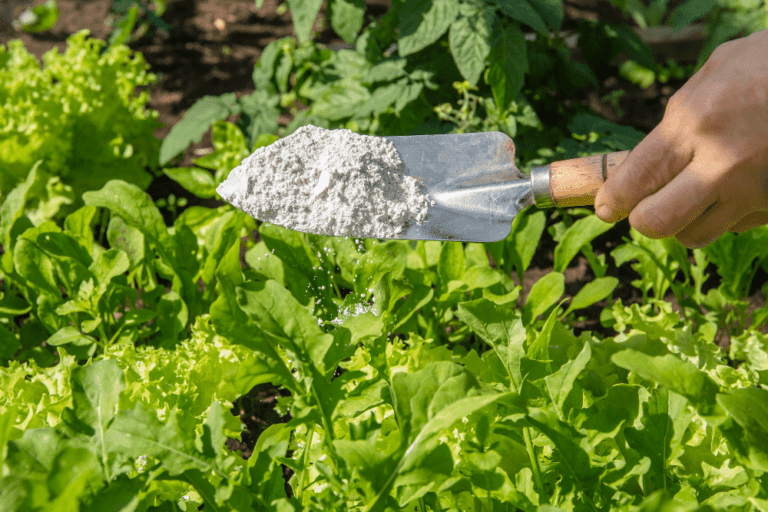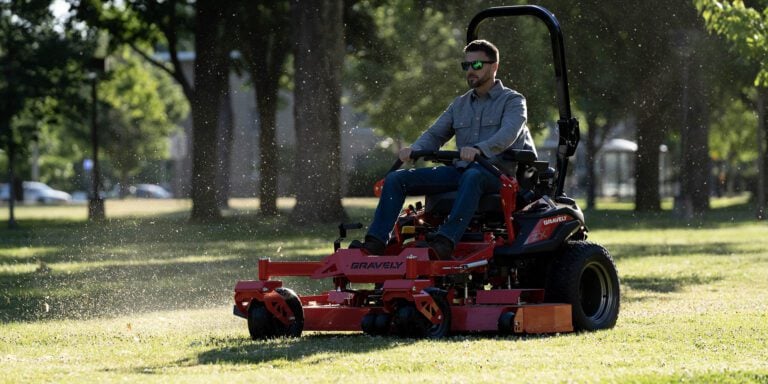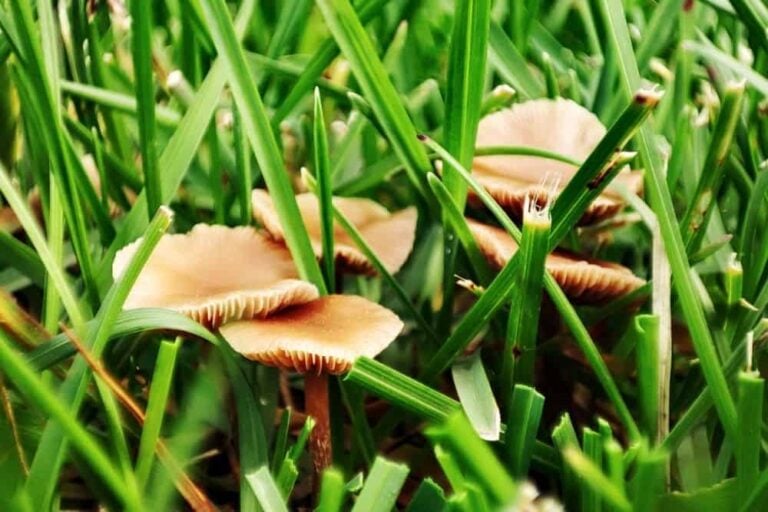15 Perfect White Flowering Trees For Your Backyard
Trees and shrubs are found in most backyards across the country, but not all of them have the ability to produce flowers.
And if they do at least bloom pretty blossoms in spring, these petals aren’t likely to stay longer than a few weeks at a time. To make your backyard stand out, you might be looking for a flowering tree.
You can’t go wrong with white flowers. Each white flower species has its own meaning, but with white symbolizing purity, sympathy, and innocence, they make for a simple and elegant symbolic reference to your garden.
Plus, white flowers look stunning and can brighten up even the shadiest parts of your backyard.
If you’re looking to spruce up your backyard, you’ve come to the right place. Here are the top 15 perfect white flowering trees for your backyard!
Halesia Carolina (Carolina Silverbell)
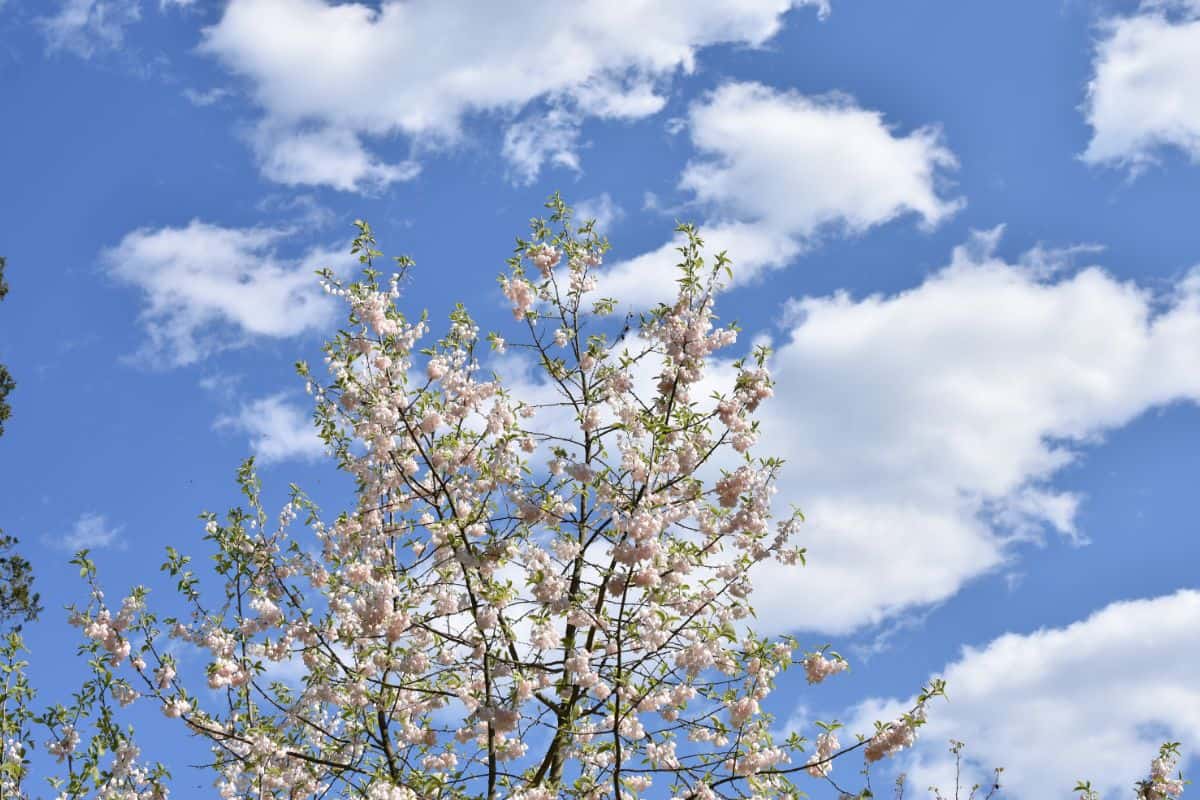
Also known as the mountain snowdrop tree, the Carolina silverbell is a small to medium-sized, fast-growing tree native to the Southeast United States and the Appalachian Mountains.
These deciduous trees are most commonly found growing on the slopes of mountains and riverbanks in the wild.
Despite this, the Carolina silverbell is commonly grown as a landscaping tree, as they can be grown in a variety of hardiness zones and exposures. They reach heights of 30-40 feet in 20 to 50 years.
As the name suggests, this species produces beautiful white bell-shaped flowers that form in groups and hang from the branches.
These flowers are often tinged pink on the inside and will come with pale green fruits that bloom in fall. The flowers bloom in April along with the new leaves.
While this species produces an autumnal yellow-green foliage in fall, the leaves drop early. The best flowers to grow underneath a halesia Carolina are rhododendrons and azaleas.
- Height: 30-40 feet
- Hardiness zone: 4-8
- Soil requirements: Medium moisture, neutral pH
- Sun requirements: Full sun to partial shade
- Bloom time: April
Amelanchier (Serviceberry)
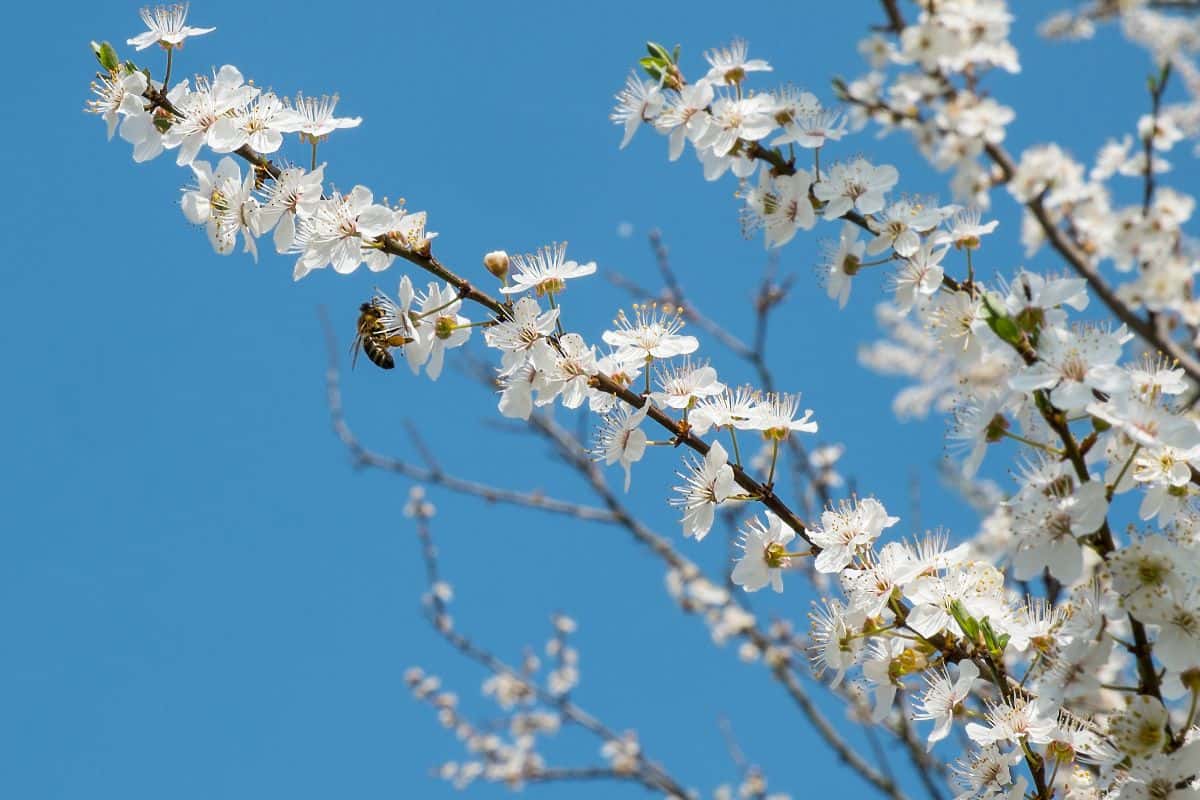
Also known as sugarplum, shadbush, shadblow, juneberry, or chuckly pear, the serviceberry is a flowering tree (or shrub) genus of approximately 20 species.
The unique “serviceberry” name derives from New England folklore, which explains how the tree’s flowering time coincided with the thawing of snow, which signified the time when funeral services could be held again (as the thawed ground could be dug into for caskets).
This, along with the white flowers the tree produced, inspired the name “serviceberry”.
The serviceberry is a dense, small tree with thin winding branches that bloom star-shaped white flowers in spring. The species is a blend between a shrub and a small tree, and looks effortlessly graceful in a garden.
Along with the flowers, the serviceberry blooms small edible berries that resemble blueberries in June (though they aren’t as flavorsome as real blueberries). The green foliage turns yellow-red in fall.
- Height: 25-30 feet
- Hardiness zone: 4-8
- Soil requirements: Medium moisture, neutral pH
- Sun requirements: Full sun to partial shade
- Bloom time: April and May
Camellia Japonica ‘White By The Gate’ (Camellia)
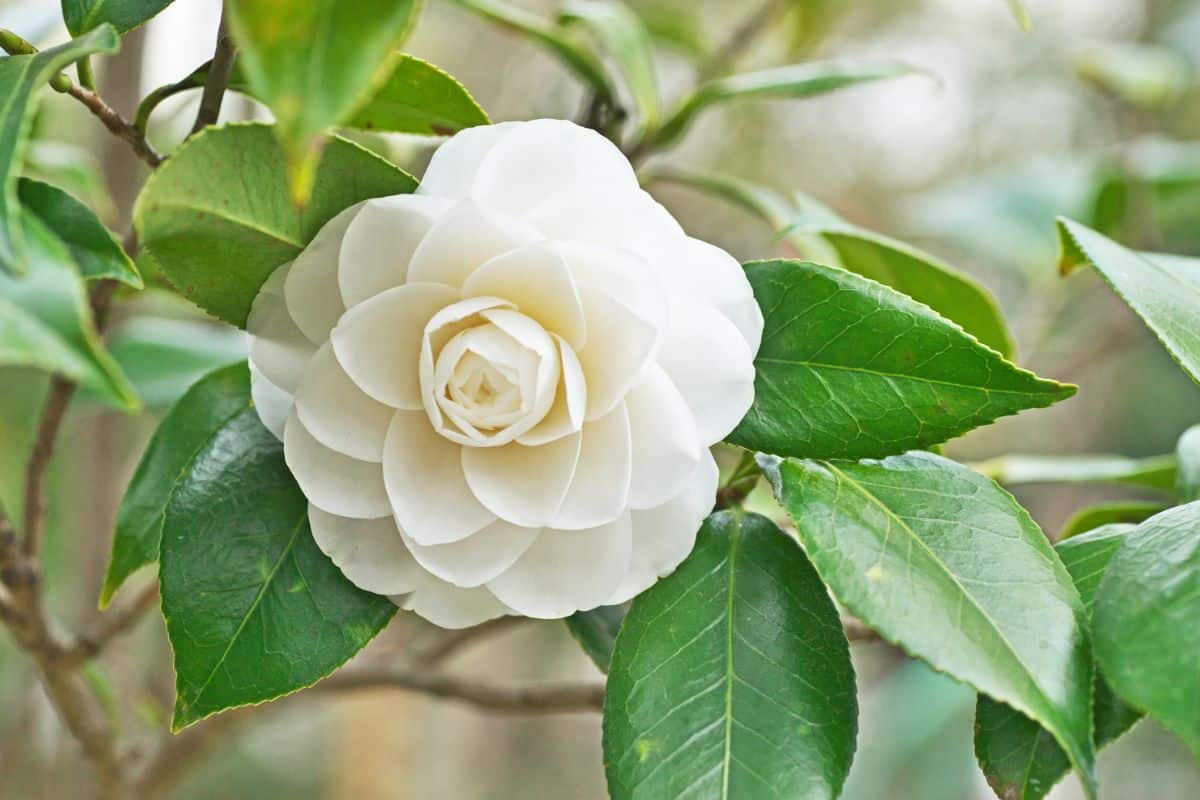
You don’t get more classic than a beautiful camellia. The ‘White By The Gate’ variety of Camellia Japonica, as the name suggests, produces elegant white flowers that, interestingly enough, bloom in fall.
This is why these trees are often planted amongst flowering trees that bloom in spring, so flowers can be seen throughout the year.
Camellia Japonica is a showy broadleaf evergreen that typically grows in the warmer regions of the United States.
While most Camellia flowers are pinkish, this particular variety produces white flowers between November to April, mostly lasting all the way through winter. The species doesn’t grow very tall, making them ideal for smaller gardens.
The only downside to ‘White By The Gate’ camellias is that the species is prone to developing mold and fungal issues. Still, if you live in a warmer climate and take care of the tree, they are a beautiful addition to your backyard.
- Height: 8-12 feet
- Hardiness zone: 7-9
- Soil requirements: Moist, slightly acidic pH
- Sun requirements: Partial sun and filtered shade
- Bloom time: November to April
Malus ‘Sugar Tyme’ (Crabapple)
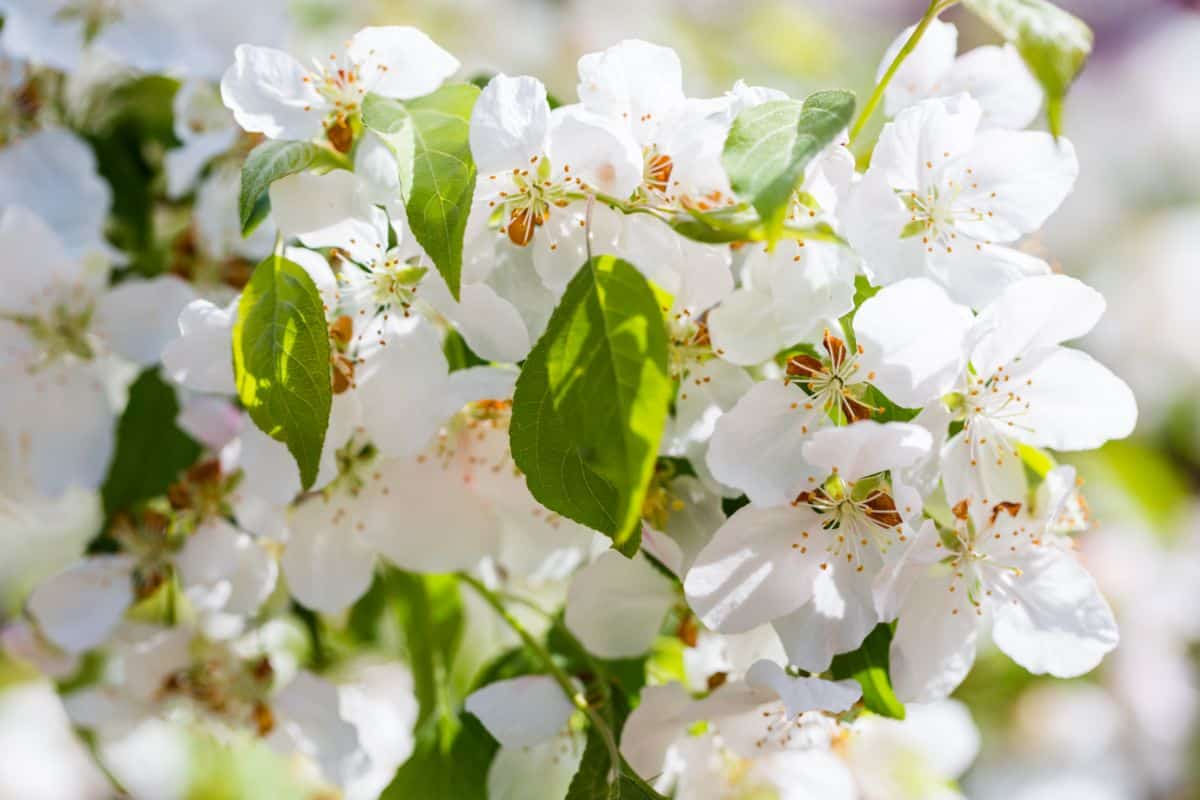
Flowering crabapples are one of the most popular species of flowering trees found in backyards across the country, producing flowers in a range of colors.
The sugar tyme variety is a particularly beautiful crabapple, producing white (and often with hints of pink) flowers in springtime.
While the bloom time is brief compared to other species on our list, this is still an impressive tree. It doesn’t just produce a sprinkle of flowers, it produces a sea of white petals that cover the whole tree.
The foliage is completely covered, making the tree appear entirely white. These flowers also smell beautiful!
Once the flowers fall, the tree blooms clusters of red crabapples that, unfortunately, aren’t edible. Still, this is a lovely splash of color to replace the white petals.
These fruits last until the next spring and are a great snack for birds, so if you want to attract birds to your backyard, this tree will do the trick.
- Height: 14-18 feet
- Hardiness zone: 4-8
- Soil requirements: Medium moisture, neutral pH
- Sun requirements: Full sun
- Bloom time: April
Prunus Virginiana (Chokecherry)
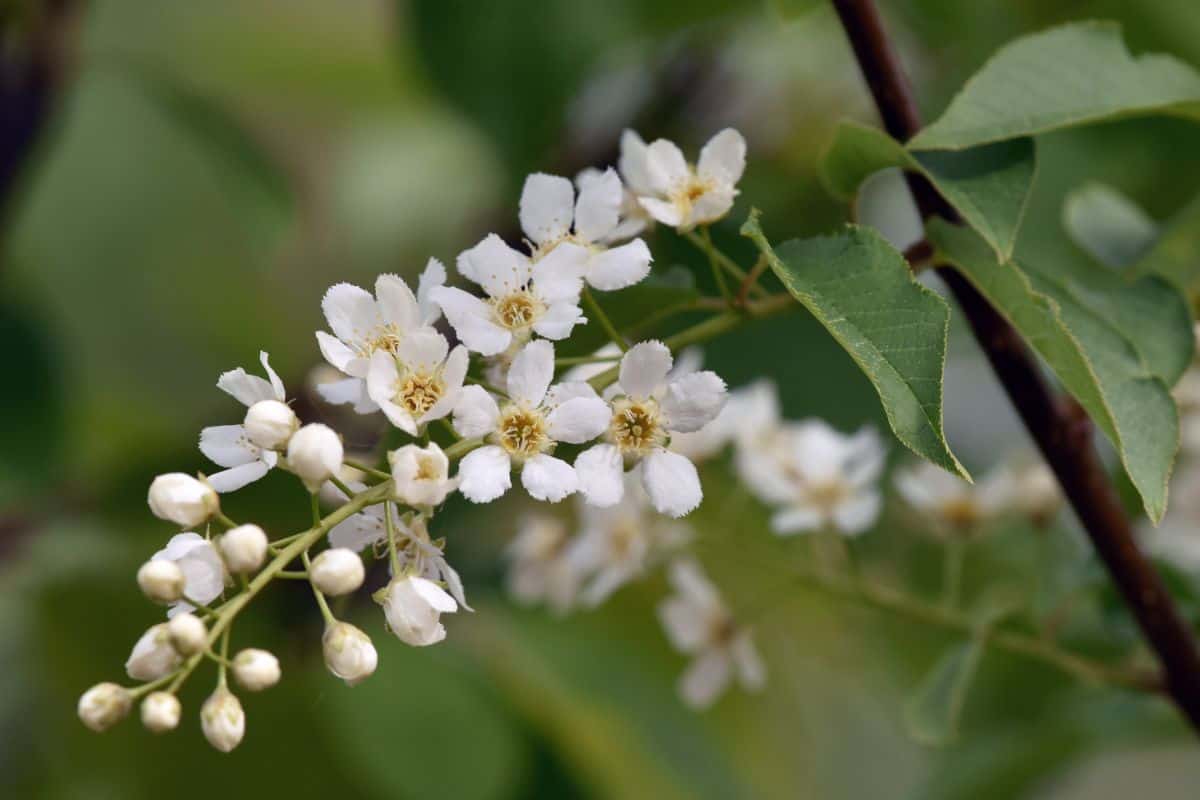
Also known as the Virginia bird cherry and bitter-berry, the chokecherry is a bird cherry tree species native across North America.
This is a shrub or small tree commonly grown in woodlands and naturalized backyards thanks to its rugged and wild appearance.
The chokecherry produces dark green oval-shaped leaves and clusters of small white flowers in spring. As the name suggests, these flowers are the gateway to copious red berries that are commonly picked for jams and jellies.
Birds and local wildlife are known to feast on these berries, which is also why chokecherry trees are grown in woodlands.
The only downside to chokecherry trees is that they propagate incredibly easily through suckering. While this means this is great for propagation, you’ll need to maintain the tree regularly to prevent it from becoming invasive.
- Height: 20-30 feet
- Hardiness zone: 2-7
- Soil requirements: Dry or medium moisture, neutral pH
- Sun requirements: Full sun or partial shade
- Bloom time: April and May
Hydrangea Paniculata ‘Limelight’
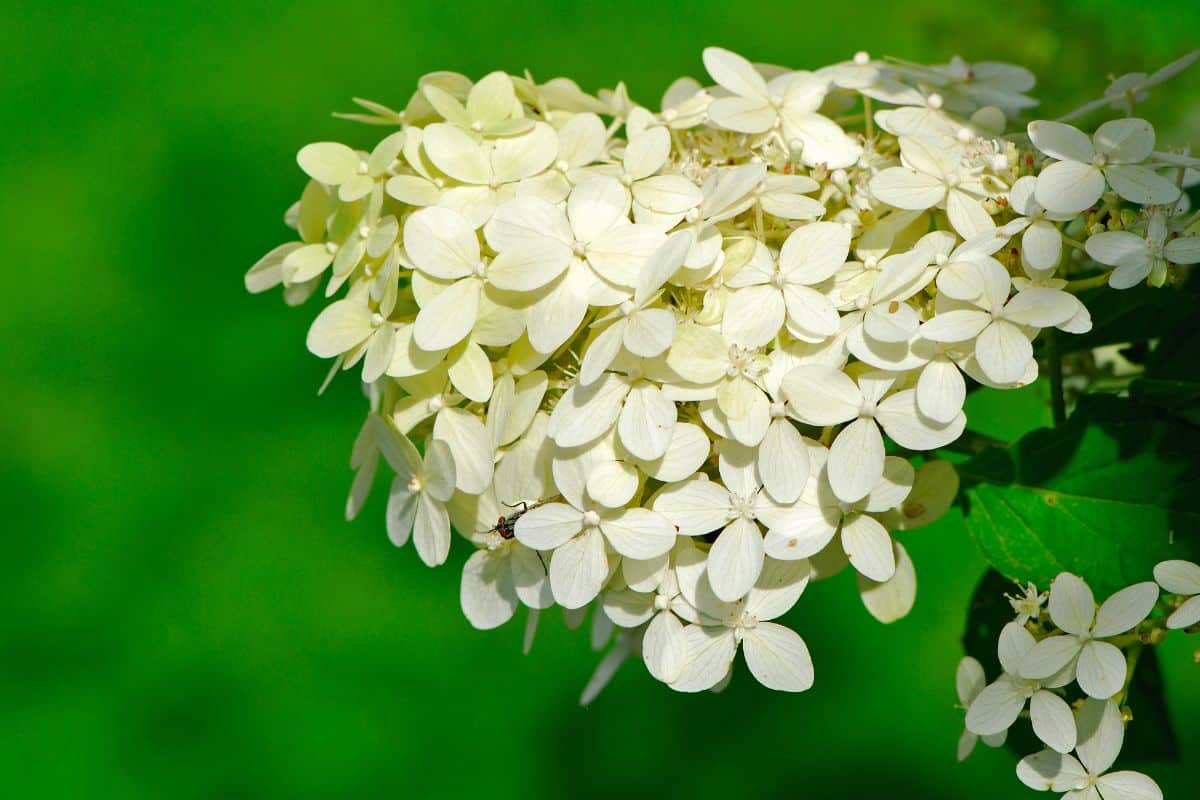
Growing to heights of 6 to 8 feet tall, hydrangea paniculata ‘limelight’ is actually one of the smallest shrubs on our list. Still, with regular pruning, you can consider this species a small tree. Plus, its size makes it a great contender for small backyards.
Also known as the “tree-form hydrangea”, this species is known for its impressive hydrangea flowers that – as the name ‘limelight’ suggests – are white with a greenish tint.
These conical flowers grow on sturdy stems and make for an impressive display. While greenish at first, the flowers turn white in summer before going deep pink and finally to beige in fall.
Interestingly, the bloom time for this species is fairly late. The flowers appear in summer rather than spring and will change colors rather quickly until fall.
Along with the reddening blooms, the foliage of this tree will turn reddish in fall, making it an attractive species throughout the year.
This particular variety needs to be pruned in late winter to early spring to promote reliable flowering – which also helps to protect the tree from mildew, bud blight, rust, and bacterial wilt.
- Height: 6-8 feet
- Hardiness zone: 3-8
- Soil requirements: Medium moisture, neutral pH
- Sun requirements: Full sun and partial shade
- Bloom time: July to September
Orange Jasmine (Murraya Paniculata)
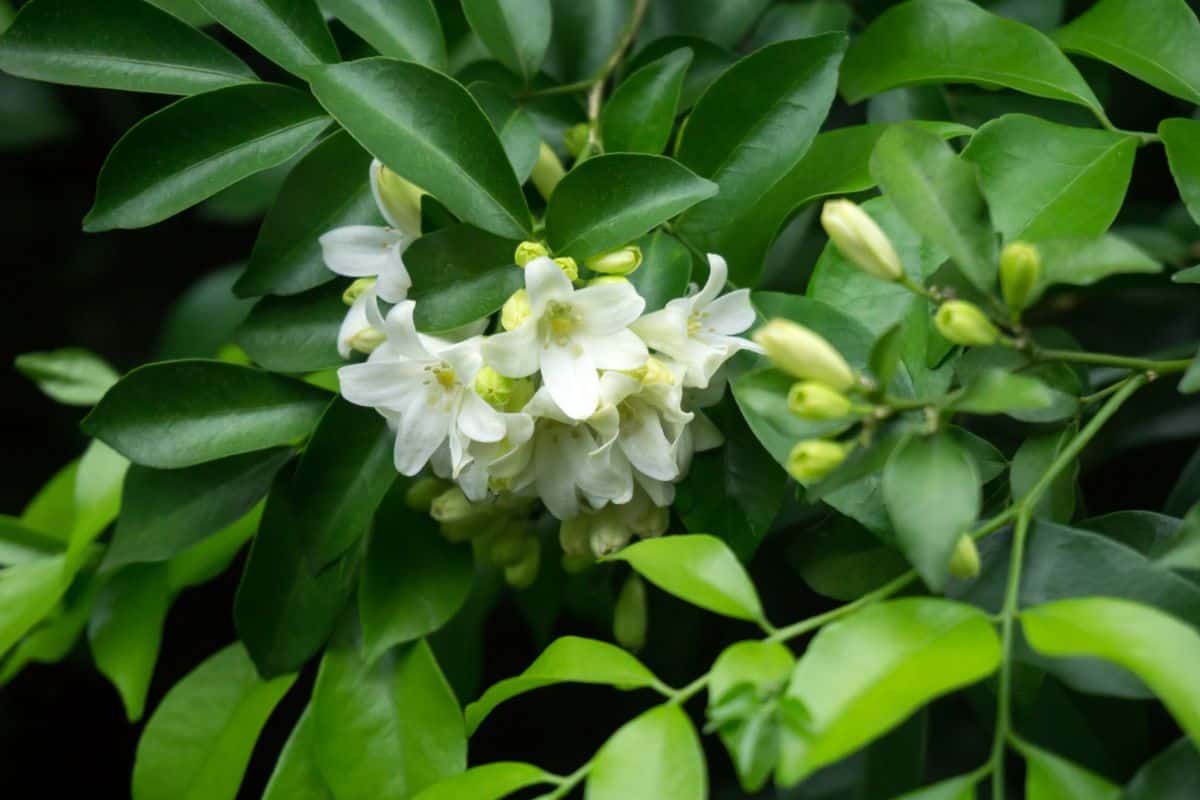
Also known as orange jessamine, mock orange, and china box, the orange jasmine is a shrub (or small tree with adequate pruning) that is native to Australia and South and Southeast Asia.
It prefers to grow in warm climates, but can tolerate cooler climates when grown in a container.
Orange Jasmine is an attractive species consisting of glossy evergreen leaves, smooth bark, and fragrant creamy-white flowers arranged loosely in groups.
Bloom time is throughout the year, allowing for a long-lasting scattering of white flowers. Throughout the year, the blooms will produce orange-red berries.
In hardy climates, orange jasmine trees are known to grow up to 8-12 feet tall. In cooler climates, it is popularly grown in containers, which allows the trees to be brought inside during winter.
Fortunately, the orange jasmine tolerates pruning, so it can be kept in large pots without overflowing.
- Height: 8-12 feet (Depending on if it’s planted in the ground or container)
- Hardiness zone: 10-12
- Soil requirements: Moist, tolerant of moist soil types
- Sun requirements: Full sun
- Bloom time: Year-round
Chionanthus Virginicus (Whitefringe Tree)
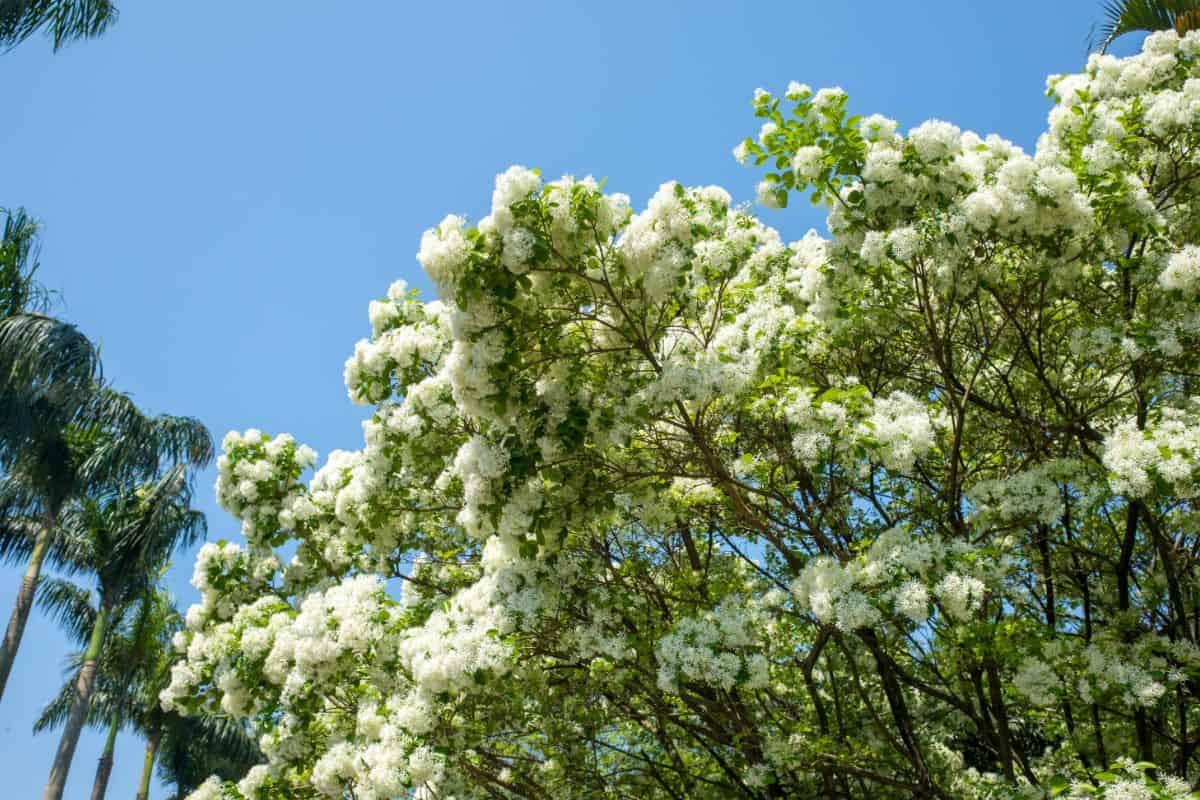
The whitefringe tree, native to the lowlands and savannas of the Southeast United States, is one of the lesser-known species of white flowering trees on this list.
This is a surprisingly hardy tree that tolerates all climates, meaning those living in cooler climates can still enjoy the unique species.
This small tree produces fragrant lacy, fringe-like white flowers that hang in bundles.
Its light and almost fluffy appearance makes for an interesting and unique addition to a backyard – particularly as the species is dioecious, meaning the plants are either male or female. Still, some trees have exhibited both female and male flowers.
The flowers bloom from May to June. Afterwards, the female flowers are replaced by dark blue grape-like fruits.
Unfortunately, the whitefringe tree is under threat from the emerald ash borer, an exotic beetle pest that feeds off ash trees.
These pests are found in at least 35 states (as well as Canadian provinces) and have recently been found to feast off whitefringe trees. While beautiful, this is worth knowing if you live in an area of emerald ash borers.
- Height: 12-20 feet
- Hardiness zone: 3-9
- Soil requirements: Medium moisture, neutral pH
- Sun requirements: Full sun and partial shade
- Bloom time: May to June
Magnolia Macrophylla (Bigleaf Magnolia)
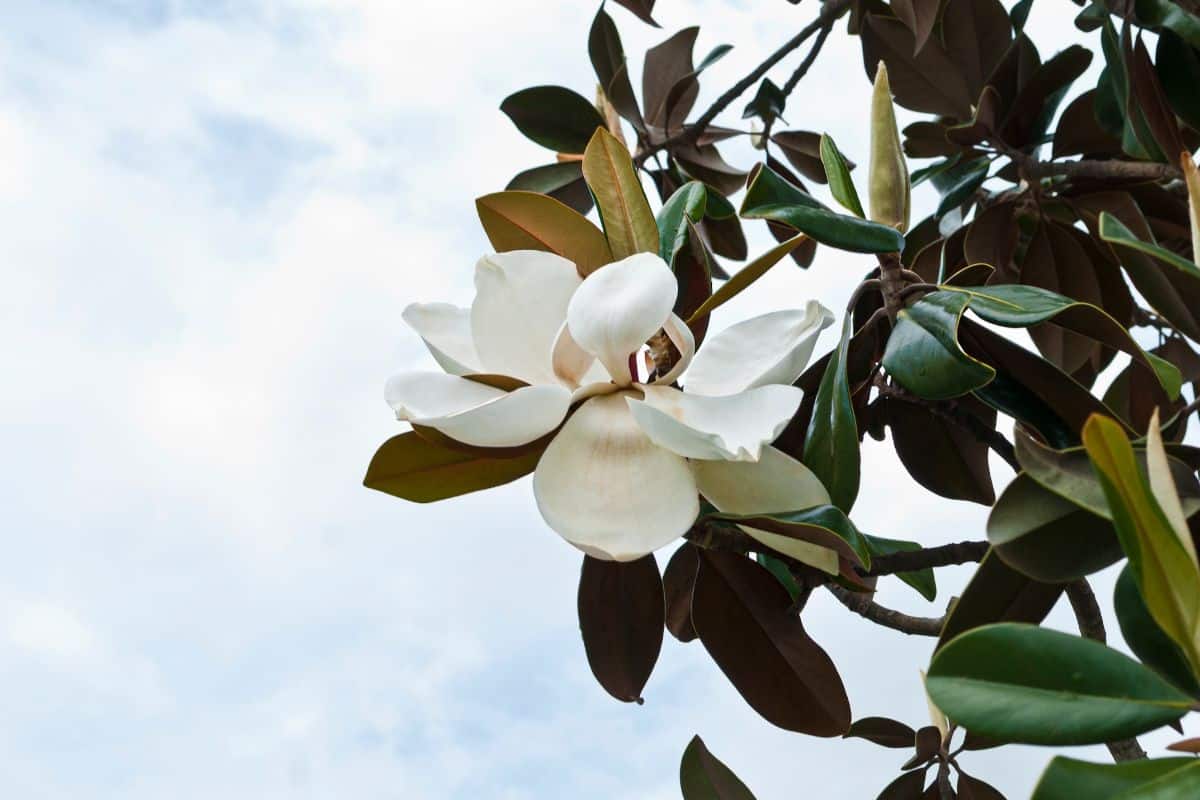
The bigleaf magnolia is native to Southeastern United States and eastern Mexico, and interestingly produces the largest leaf of any native North American tree – which is a valid reason alone to have one of these beauties in your backyard.
Aside from its iconic large leaves, the bigleaf magnolia produces large white flowers, consisting of six to nine petals arranged in a bowl-like shape.
While white, the flowers exhibit a purplish hue on the base. When in their bowl shape, the flowers are known to hold dead insects like bees.
The bigleaf magnolia will produce large red fruits that are fairly spiky in texture.
Keep in mind that if you want a bigleaf magnolia tree for their impressive white flowers, the flowers might not appear until 12 years into the tree’s life. This is why most people avoid planting these trees as juveniles.
Unfortunately, the bigleaf magnolia is an endangered species due to loss of its natural habitat.
- Height: 30-40 feet
- Hardiness zone: 5-8
- Soil requirements: Medium moisture, neutral pH
- Sun requirements: Full sun and partial shade
- Bloom time: May
Cornus Kousa (Kousa Dogwood)
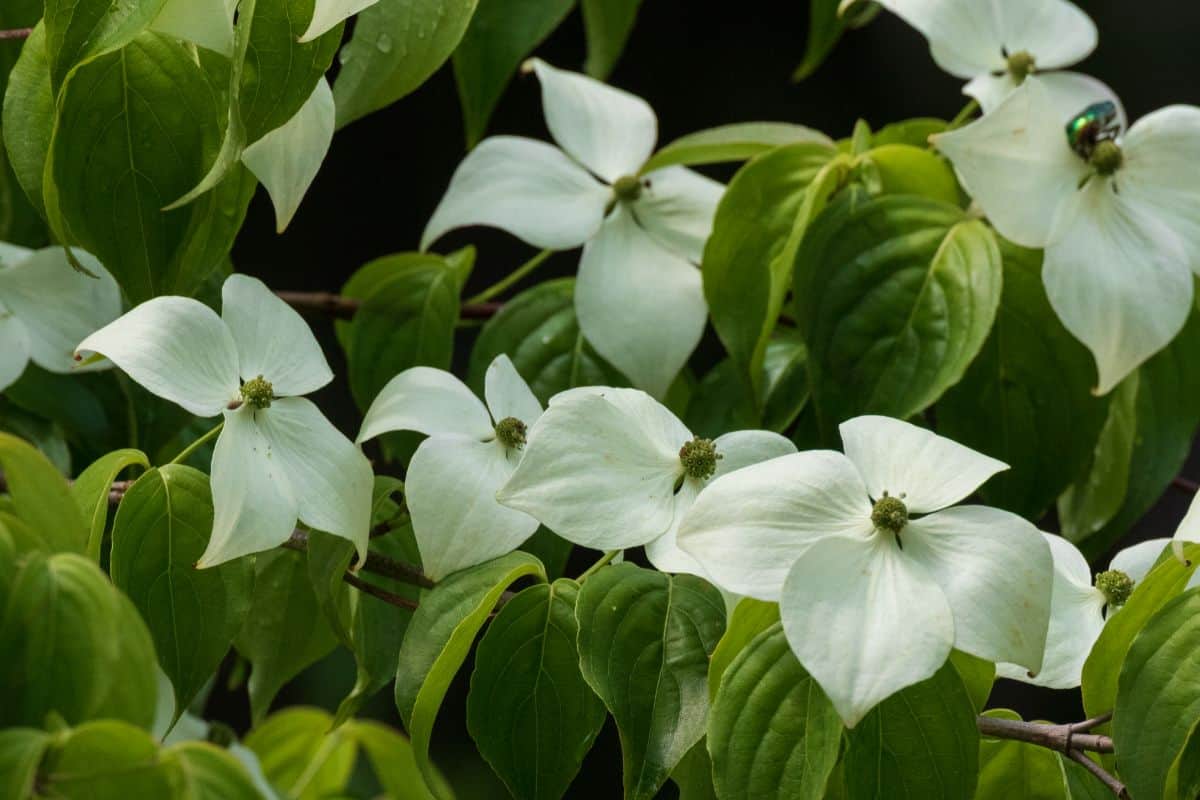
Dogwood trees are highly popular across the country, but the kousa dogwood variety has become particularly popular in recent years for its handy qualities.
One of these qualities is that kousa dogwood trees are resistant to disease, which is ideal for those living in disease-prone backyards.
Interestingly, this species is native to East Asian countries, such as Japan, China, and Korea. It was naturalized in New York State and has since been cultivated as an ornamental plant.
The kousa dogwood provides an aesthetic canopy of white flowers, blossoming in late spring and covering the majority of the tree. Alongside the flowers grows red berries that grow in clusters.
Not only do they add to the aesthetic appeal, but the berries are sweet and creamy! They are commonly used as an ingredient in wine.
Another common identifier of the kousa dogwood tree is its unique camouflage-like bark, exhibiting varying shades of tan and brown to produce a fascinating color scheme.
- Height: 15-30 feet
- Hardiness zone: 5-8
- Soil requirements: Medium moisture, slightly acidic pH
- Sun requirements: Full sun and partial shade
- Bloom time: May to June
Lagerstroemia ‘Natchez’ (Crape Myrtle)
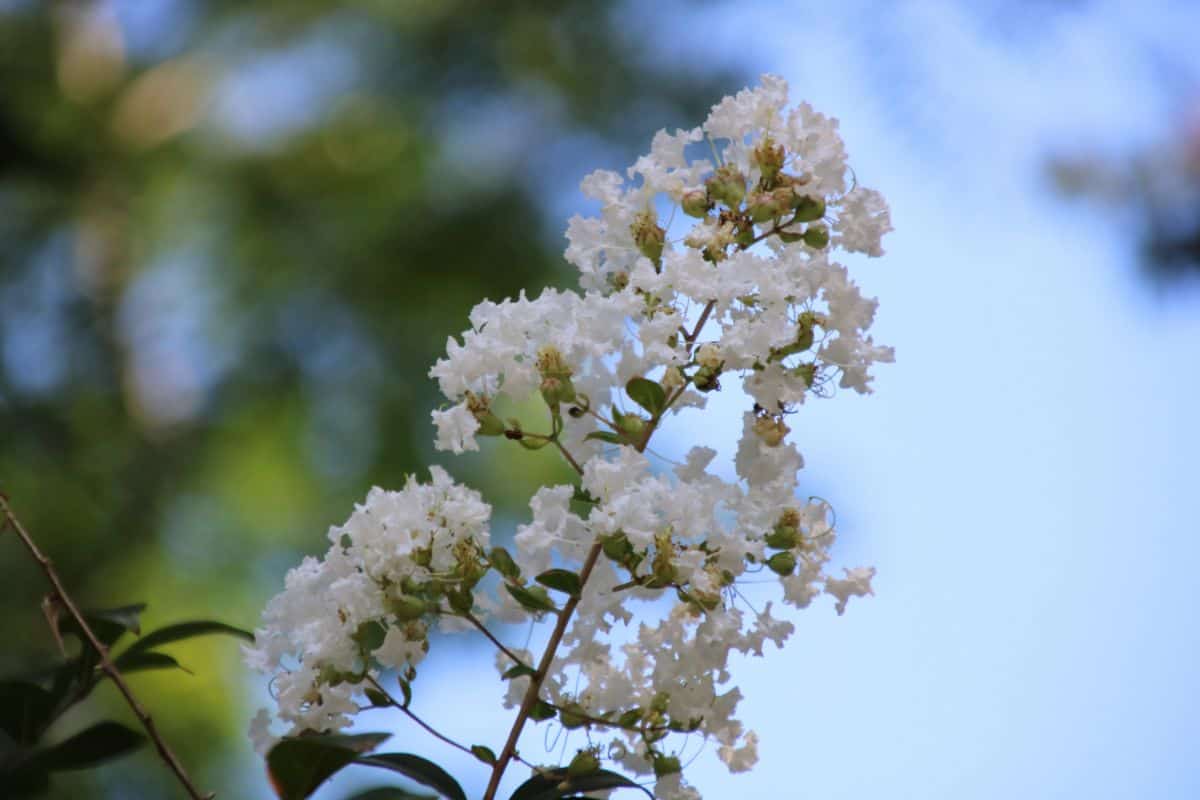
In a genus of around 50 species, crape myrtles are one of the most popular flowering trees in warmer climates. Crape myrtles are native to parts of Australia, India, and Southeast Asia, though they are now cultivated across the warmer climates of the world.
The ‘natchez’ crape myrtle variety is popular for producing bunches of delicate white flowers, consisting of several frilled petals and growing in clusters.
These fluttery flowers make the ‘Natchez’ variety a prized possession in any backyard, covering the majority of the tree with a sea of delicate white frills.
The flowers are accompanied by green capsule fruits that then ripen to a dark brown, providing a stark contrast to the white flowers. In fall, the surrounding leaves turn reddish as the flowers begin to drop, making for a fascinating contrast and change.
Plus, the ‘natchez’ variety is also resistant to mildew, making it an ideal addition to backyards in all warm climates.
- Height: 4-20 feet
- Hardiness zone: 6-9
- Soil requirements: Medium moisture, neutral pH
- Sun requirements: Full sun
- Bloom time: July to September
Pyrus Calleryana ‘Bradford’ (Callery Pear)
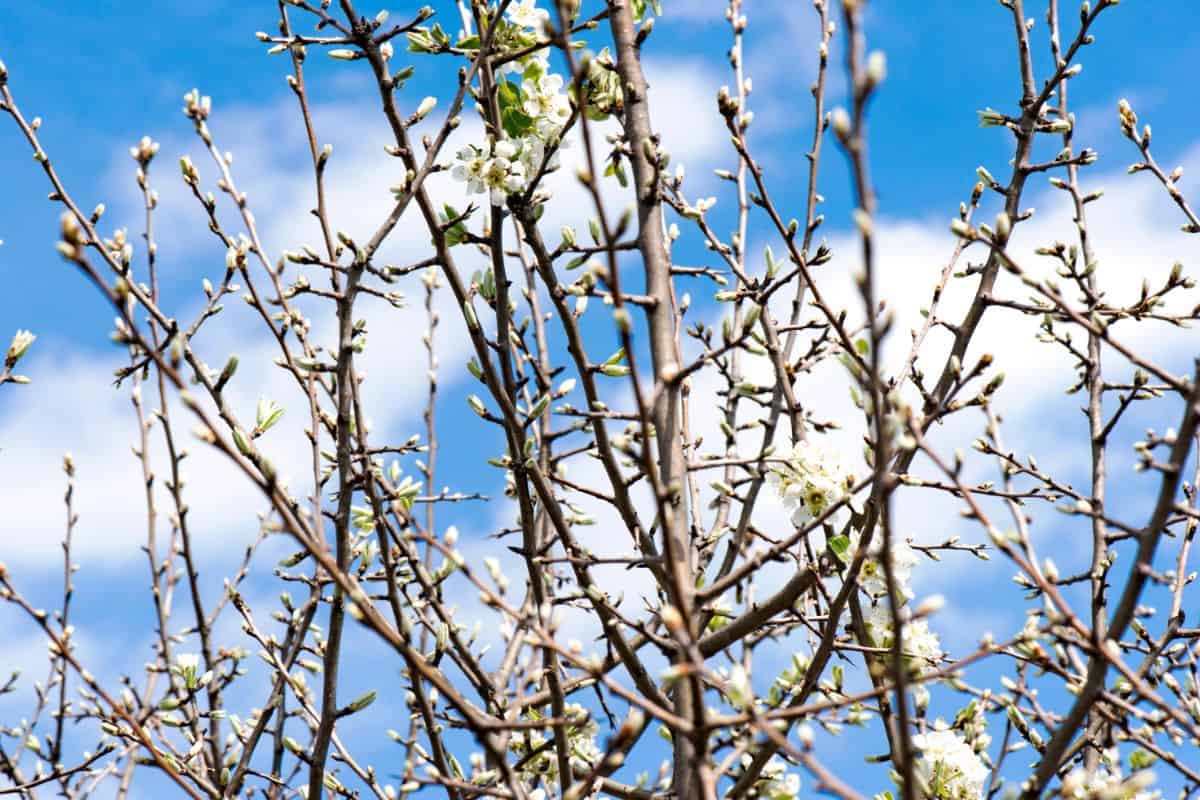
Also known as the Bradford pear, the callery pear is a beautiful pear tree species native to Vietnam and China.
The ‘Bradford’ cultivar is most popularly grown in the United States, but due to its vast growth, it is considered an invasive species. Make sure to check your local authority to see your region’s invasive species list.
This is a classic springtime tree, where the majority of the tree is covered in delicate white flowers that brighten up any garden – even in residential and urban settings. However, don’t be fooled by its production of fruit.
While it’s a type of pear tree, these pears are not edible due to the cyanide-laced seeds). Instead, the pears are small and green, and easily hidden by the white flowers.
However, the callery pear tree is known to have some structural issues. The branches are very narrow as they grow from the trunk, making them prone to breakage.
This is why the tree is often considered invasive. The best way to prevent breakage is to prune the branches, so they’re lightweight.
- Height: 30-50 feet
- Hardiness zone: 5-9
- Soil requirements: Medium moisture, neutral pH
- Sun requirements: Full sun
- Bloom time: April
Syringa Reticulata (Japanese Tree Lilac)
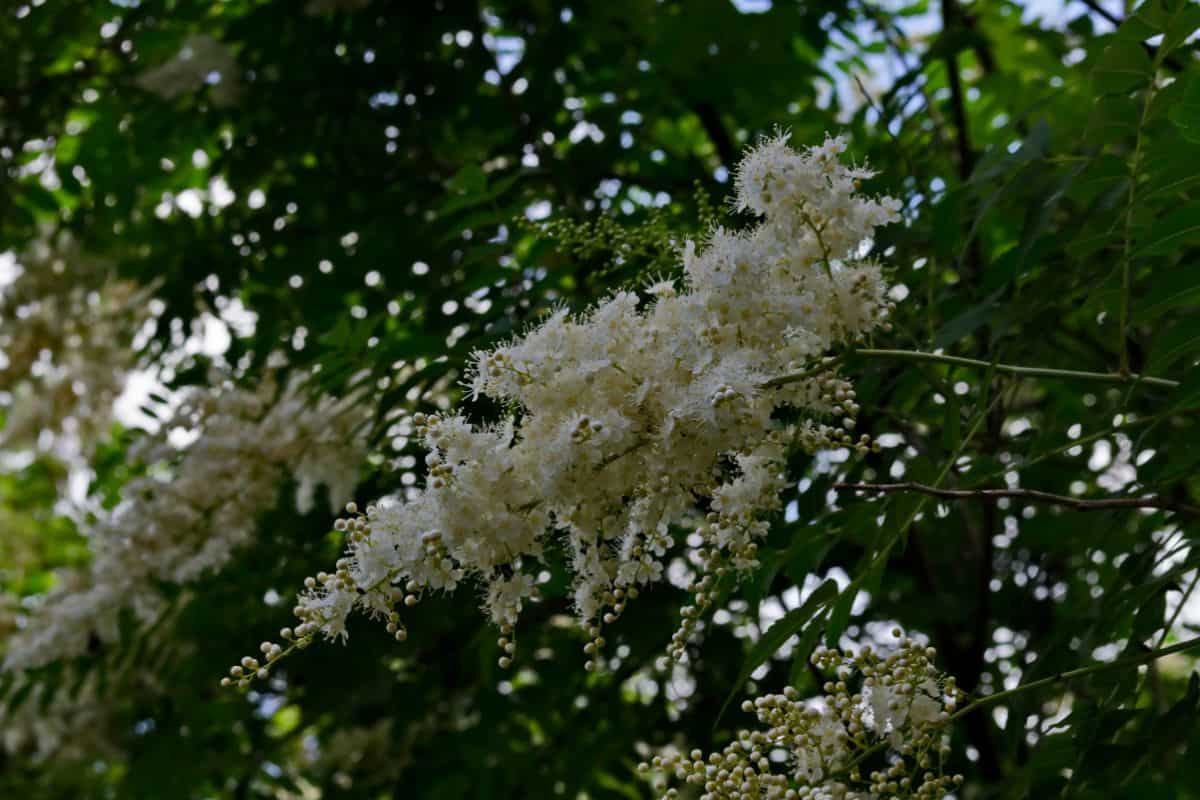
Native to Eastern Asia, the Japanese tree lilac is a beautiful species commonly grown as an ornamental tree in Europe and across North America.
Common lilac is typically associated with its pretty fragrance and purplish coloring, but the Japanese tree lilac exhibits larger lilac flowers in a white color.
This is a large shrub or small tree that produces clusters of tiny white lilac flowers, producing a strong fragrance that is a beautiful addition to a backyard – especially when planted near a path, so you can walk by the fragrance.
The leaves are also similar in shape to the common lilac, but are slightly darker.
The Japanese tree lilac is best grown in full sun, so it can provide a generous amount of shade. Plus, the more sun it receives, the more flowers it produces. These trees are commonly planted in large backyard or park spaces thanks to the shade it produces.
- Height: 20-30 feet
- Hardiness zone: 3-7
- Soil requirements: Medium moisture, neutral pH
- Sun requirements: Full sun
- Bloom time: June
Styrax Japonicus (Japanese Snowbell)
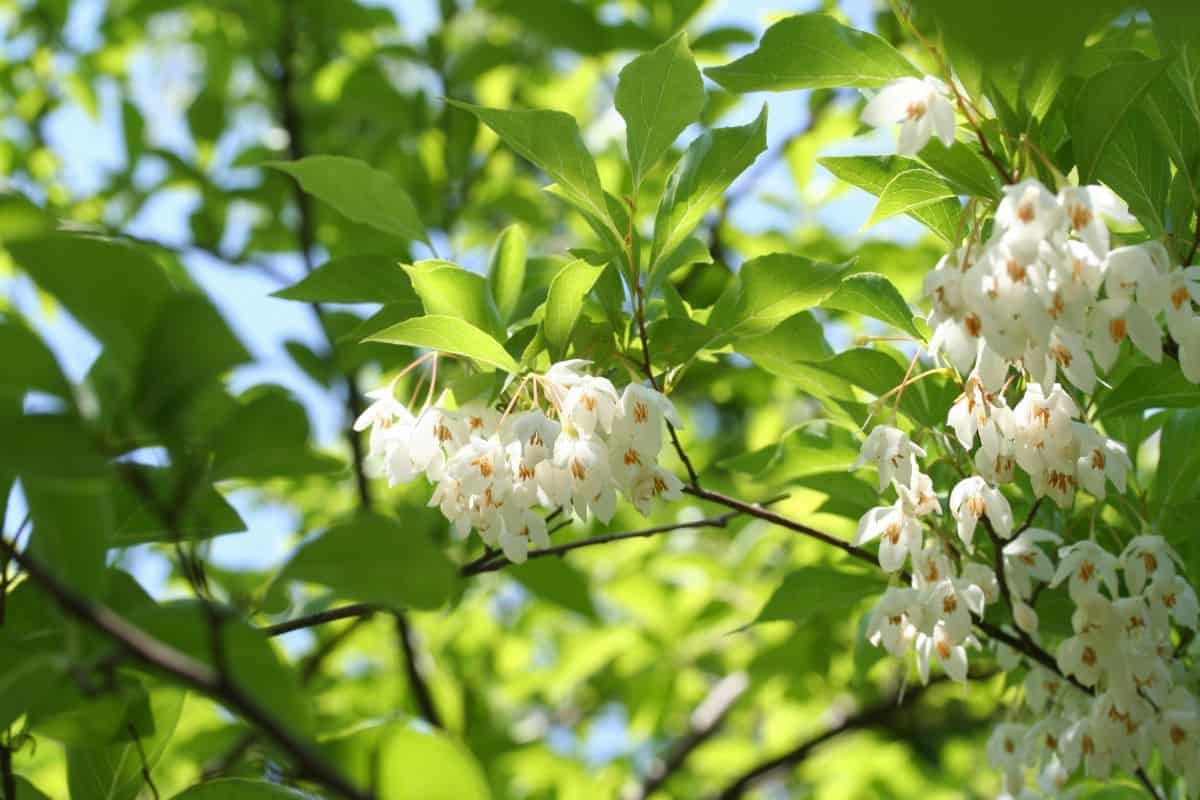
Belonging to the Carolina silverbell (the first species on our list), the Japanese snowbell is a flowering plant native to Korea, China, and of course, Japan. This is a charming deciduous tree that produces upright oval leaves and small, white, bell-shaped flowers.
As a result of the upright leaves, the bell-shaped flowers droop below, meaning they are best viewed from underneath the tree.
When standing underneath the canopy, the flowers and leaves make you feel like you’re in a fairy tale. The tree also produces drupe fruits that resemble the color and shape of olives.
The canopy itself is naturally shaped like a circle, making this species ideal for landscaping. Plus, the fruit helps to attract local wildlife such as birds and bees to the garden.
However, this is a slow-growing tree with an average growth rate of 12-14” per year. You might want to plant a mature Japanese snowbell if you want the flowers immediately.
- Height: 20-30 feet
- Hardiness zone: 5-9
- Soil requirements: Medium moisture, acidic pH
- Sun requirements: Full sun and partial shade
- Bloom time: May and June
Aesculus Californica (California Buckeye)
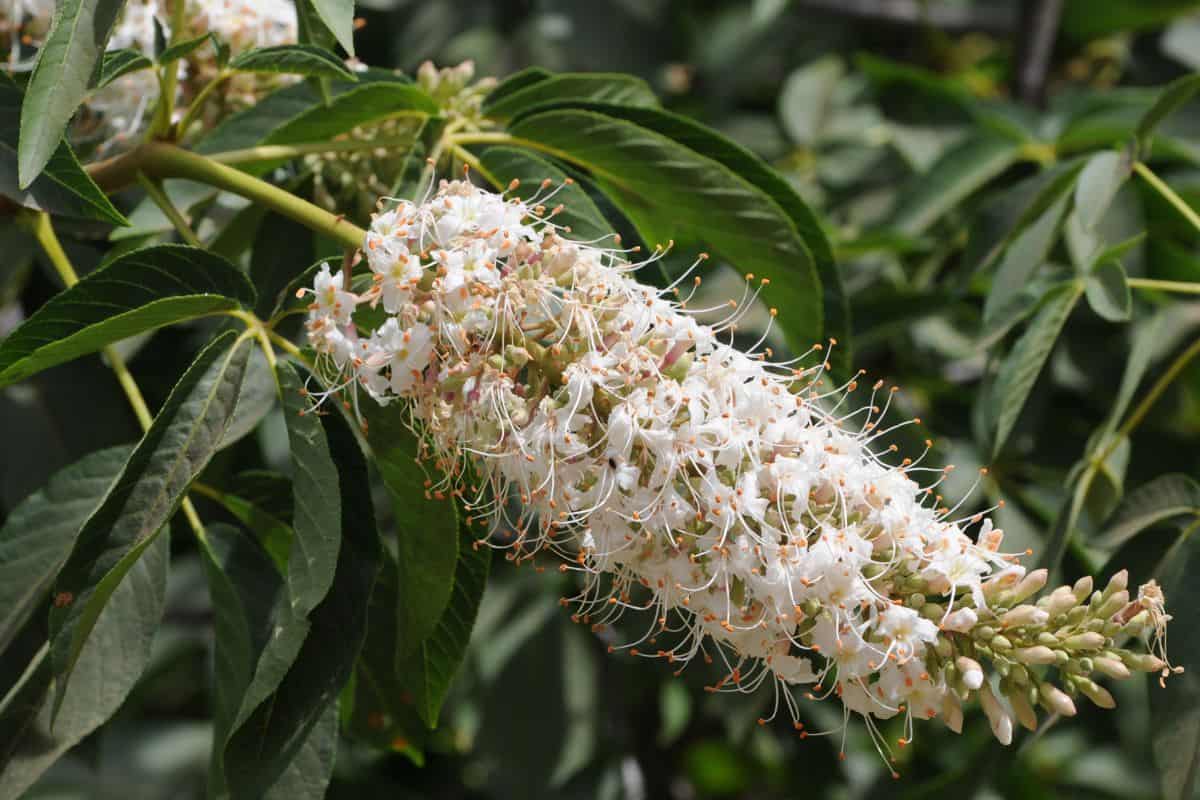
Also known as the California horse chestnut, the California buckeye is a buckeye species native to – you guessed it – California (as well as southern Oregon).
This is a large shrub (or small tree with pruning) that often looks quite wild thanks to the gray bark that is usually covered in moss and lichens.
The best part of the California buckeye, however, is the bloom of white flowers. These flowers are fairly large and bloom in spring, producing a pleasant sweet fragrance. Following the flowers, the tree produces fruit resembling a chestnut in a pale capsule.
However, it’s worth noting that every part of the California buckeye is poisonous, including the bark, fruit, leaves, and flowers.
Make sure to keep children and pets away from the consuming parts of the tree. Still, when planted in a safe space, this is a stunning addition to a backyard.
- Height: 15-30 feet
- Hardiness zone: 7-8
- Soil requirements: Medium moisture, neutral pH
- Sun requirements: Full sun and partial shade
- Bloom time: February and March
Conclusion
So, there you have it! Turns out, there’s probably a bunch more white flowering tree species than you first thought. Every species on our list is suitable to be grown in a variety of backyards, making for an attractive addition to all spaces – from borders to large lawns.
The key to planting a tree or large shrub is making sure that you can meet its requirements. While most trees are fairly hardy and tolerant of most soils, you should make sure the environment is ideal for the species to make the most of its glorious flowers.


